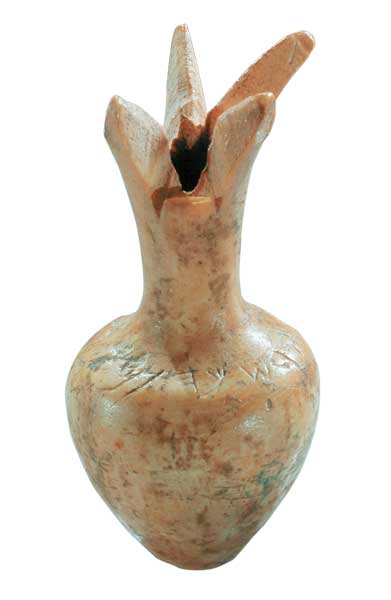
“In September 2004 the directors of the Israel Museum and the Israel Antiquities Authority (IAA) appointed a special committee in order to examine the authenticity of the ivory pomegranate [inscription] from the Israel Museum.” So states the committee’s resulting report, published in 2005.
If the inscription on the pomegranate (“(Belonging) to the temple of [Yahwe]h; holy to the priests”) is authentic, the pomegranate is probably the only surviving relic from Solomon’s Temple. The Israel Museum paid $550,000 for the object in 1988 after the inscription had been authenticated by Nahman Avigad, Israel’s then-leading script expert.
When this joint committee was appointed, a different committee, appointed by the IAA alone, had already declared the James Ossuary inscription (“James, son of Joseph, brother of Jesus”) a forgery in 2003. This time, however, it would be a committee not only of the IAA but also of the Israel Museum.
It now turns out that the pomegranate committee was not a joint committee at all. The committee members were “determined and led” by the IAA, according to an Israel Museum curator. Michal Dayagi-Mendels, chief curator of archaeology at the museum, states that, although she is listed as a member of the committee, she was there only as an observer.
The so-called joint-committee report was published in the Israel Exploration Journal, where Dayagi-Mendels is listed as one of the authors.1 She states, however, “I did not participate in writing the article, and my name was added without my knowledge.”
Of how many other “committee members” is it true that they had nothing to do with the “committee” decision? We will probably never know. But it seems the IAA was determined to find the pomegranate inscription a forgery and to present the result as a unanimous committee decision that the Israel Museum supported just as the IAA did.
Other evidence suggests that, with respect to the James Ossuary inscription, the IAA decided it was a forgery even before seeing it. The ossuary with its inscription was first published in the November/December 2002 issue of BAR. The day after it was published, it made headlines around the world. The IAA was furious when the press came to it for comment and its people knew nothing about it. To make matters worse, the IAA then gave pro forma permission (despite full disclosure to the IAA of the inscription) to the ossuary’s owner, collector Oded Golan, to take the ossuary to Canada and exhibit it in the Royal Ontario Museum.
At this point the ossuary with its inscription had never been examined by the IAA. Yet the IAA decided that the inscription is a forgery; a forger had taken an authentic ossuary and forged the inscription on it.
In early January 2003, while the ossuary was still in Canada, a reporter for the Hebrew newspaper Maariv interviewed Uzi Dahari, deputy director of the IAA. On January 15, the reporter published his story. Quoting Dr. Dahari: “ ‘The forgery works in such a manner that the stone is authentic and the inscription is a forgery.’ ” The report goes on: “Dr. Dahari mentions the affair of the ossuary with the inscription about Jesus’ brother and father, which recently made headlines and caused a stir in the Christian world.”
Dr. Dahari then became chairman of the IAA committee that on June 20, 2003, would declare the ossuary inscription a forgery.
Did the reporter give the wrong pitch to Dr. Dahari’s remarks? Did Dr. Dahari, at this time, have some evidence of forgery that we don’t know about?
Or did Dr. Dahari and the IAA decide that the ossuary inscription was a forgery without ever seeing it?—H.S.

